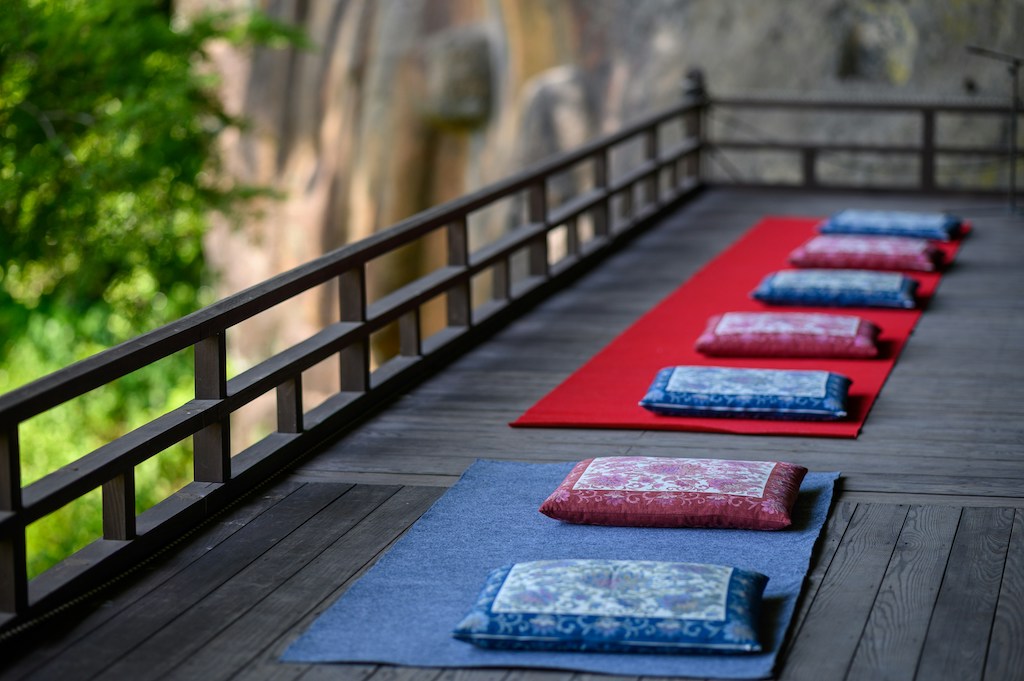The Treasure of Sangha
A Zen teacher invokes the tenets of AA in a teaching on spiritual friendship. The post The Treasure of Sangha appeared first on Tricycle: The Buddhist Review.

A Zen teacher invokes the tenets of AA in a teaching on spiritual friendship.
By Matthias Esho Birk Jun 04, 2025 Photo by Kouji Tsuru
Photo by Kouji Tsuru“Sangha is the most important,” she said. By sangha, she meant the community of practitioners gathering regularly to meditate.
I was dumbfounded. I was sitting in daisan, the regular one-on-one interview every serious Zen practitioner has with their teacher. By then, I had been studying with my teacher, Roshi Janet Abels, for several years, and I guess she’d detected a pattern. Each Tuesday night, I’d arrive just minutes before the weekly sitting, from 7:00 to 9:00 p.m., and usually dash out right afterward.
I was grateful that there was a group I could sit with, but my approach wasn’t so different from my gratitude for having a supermarket close by—it was simply a convenient way to satisfy a need. What need? Sitting still without moving for extended periods, regularly, is challenging. It had taken me years to establish even a modest at-home meditation practice: initially, half an hour in the morning, later adding another half hour in the evening. But sitting for two hours, as we did on Tuesday nights—or even more demanding, sitting for an entire weekend or week—I considered impossible without a group. The sangha provided me with structure, a fixed time, and essential support. I appreciated it but definitely viewed it as a means to an end.
The Buddha talked about the three treasures: the Buddha, the dharma, and the noble sangha. “Buddha,” essentially, is the practice of awakening—zazen. “Dharma” refers to the Buddha’s teachings. And “sangha” is the community—in the Buddha’s time, it was the monastic community of enlightened individuals, or the ideal sangha; here in New York, it was the group gathered each Tuesday night, or the conventional sangha.
You can imagine my surprise at my teacher’s remark. By this point, I’d come to recognize Zen practice as essential to living a happier life, freer from the obsessions of my mind. There were the Buddha’s teachings and the countless Zen and Buddhist books I admired and devoured (prompting my wife’s amused observation: “How many Zen books can one person read?”). And then there were the dozen or two dozen people who regularly came together on Tuesday nights. How could sangha possibly compare in greatness to these other two treasures? How on earth could sangha be considered the most important?
In the Upaddha Sutta, the Buddha is visited by his close disciple and attendant Ananda, who, having bowed and sat down next to the Buddha, enthusiastically remarks that spiritual friendship is “half the holy life.” Seeing the potential for a teaching, the Buddha quickly corrects him, saying, “Don’t say that, Ananda. Don’t say that. Admirable friendship, admirable companionship, admirable camaraderie is actually the whole of the holy life.”
We often come to spiritual practice with the mindset: “What can I get out of this?” After all, that’s the lens through which we tend to view almost everything—relationships, work, careers, and friendships. Will this benefit me? Will this make me feel good about myself?
Enlightenment isn’t a prize separate from ourselves, something we pursue and then possess. Rather, it’s the lived realization that we were never separate to begin with.
That approach is natural and understandable, yet it’s problematic. It keeps us trapped in our fundamental delusion—the sense of being an isolated self, separate from others, always trying to control the external world to feel secure. We approach spiritual practice with questions like, “Can it free me? Can it give me enlightenment?” But enlightenment isn’t a prize separate from ourselves, something we pursue and then possess. Rather, it’s the lived realization that we were never separate to begin with.
The Buddha clearly understood this human tendency to turn spiritual practice into yet another self-oriented project. He recognized that spiritual friendship, community, and mutual support—the heart of sangha—are absolutely essential. Sangha is critical precisely because it addresses and dissolves our core delusion of separateness.
Over time, my relationship to sangha shifted. I went from being the guy who dropped in at the last minute and left right afterward to taking on various service roles—first as timekeeper, the person that arranged the flowers, or came early to make tea and put out snacks, and later as the person who opened and closed the zendo, even eventually becoming a teacher who prepares talks and sees students myself.
Bill W., the brilliant cofounder of Alcoholics Anonymous (AA), had a similar realization to the Buddha’s. When he developed AA’s Twelve Steps, he recognized something profound: that for an alcoholic, being of service to others was crucial to maintaining sobriety. Early in his sobriety, Bill discovered something unexpected—it was in helping another alcoholic stay sober that his own sobriety was strengthened. He realized sobriety wasn’t sustainable alone. By reaching out, sharing experiences, offering support, and genuinely serving another, an alcoholic not only helped someone else but also profoundly helped themselves.
In AA today, this insight is vividly lived out. Sponsorship—one sober member guiding another—is central to the AA approach. Members regularly attend meetings not just for their own benefit but also because their presence and sharing might save someone else who is struggling. In AA, caring for others isn’t simply encouraged—it’s essential, as it directly addresses the core issues at the heart of addiction: self-centeredness, isolation, and disconnection.
While many of us may not qualify as alcoholics, we are mostly certainly addicts of the mind. Addicted to thoughts, concepts, notions, especially the notion of a separate self. We obsessively chase after whatever we believe will bring us happiness, inadvertently deepening our isolation. The Buddha discovered what Bill would discover centuries later: that we must act, specifically in service to others, to dissolve our fundamental delusion of separation.
Sangha is critical precisely because it integrates all three —it embodies awakening (Buddha), it actively expresses teachings (dharma), and it offers an immediate path out of self-centeredness through service and relationship (sangha). In other words, sangha is Buddha and dharma lived in community.
JFK famously said, “Ask not what your country can do for you—ask what you can do for your country.” Next time you attend your meditation group, you might ask yourself not what you’ll get out of it but what you can give. How can you contribute, help, and support others in their practice? Not because you should or there is some kind of moral imperative. But because it may help you realize that these others are not fundamentally separate, and that by showing up and serving your fellow practitioners, you are living out enlightenment in the here and now.
![]()
Thank you for subscribing to Tricycle! As a nonprofit, we depend on readers like you to keep Buddhist teachings and practices widely available.

 Lynk
Lynk 
































